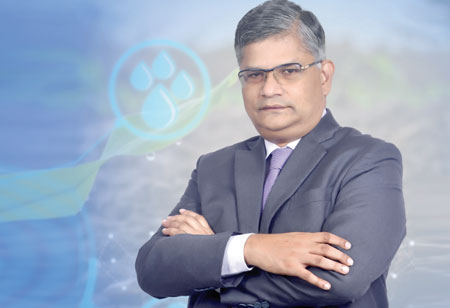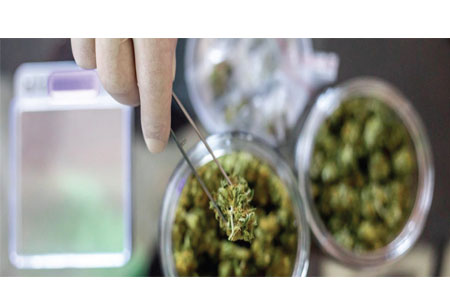
Ramesh Doraiswami: Redefining the Future Of Indian Agri-Ecosystem


Managing Director & CEO, NBHC, 0
Taking the ecosystem to the next level, NBHC recently announced the launch of its electronic application ‘Krishi Setu', a one stop solution in the postharvest Agri value chain. Heavily leveraging technology and completely digitized processes, Krishi Setu has developed a unique e-Marketplace, offering seamless user experience & reduced operational inconveniences in trade execution. At the helm of these exciting endeavors of the company is Ramesh Doraiswami, Managing Director & CEO, NBHC. Ramesh is a seasoned professional with proven experience and expertise in general management and international functional leadership of supply chain & finance functions of Fortune 100 corporations, Unilever and Johnson & Johnson. I recently got in touch with him, and he was happy to spare a few minutes for our readers. Ramesh talks about NBHCs latest endeavors in an exclusive interview with CEO Insights.

What is NBHC? And where is it positioned in the Agri-market currently?
Agri commodities, by definition are seasonal products that are processed and consumed throughout the year. Hence, one of the basic requirements of an agri business owner to access banking and finance is a warehouse. You also need to be creditworthy, as banks need security. The bank provides funding based on a receipt voucher called ‘Storage Receipt’ given by Warehouse Service providers like us. This mechanism of creating liquidity is quite unique to India. It exists pretty much only in India and some distinct regions like South Africa.
We are collateral managers who provide banks with quality & quantity guarantees on Agri commodities. NBHC came into existence as a collateral manager for the State Bank of India in 2005. As a response to further needs of the market, we subsequently started fumigation services. Today, we are the largest fumigation services provider in the country after Central Warehousing Corporation(CWC). Similarly, Quality Assaying was another service that we started. Currently, we also offer Trade Facilitation services, which include giving businesses access to credit facilities. So our interventions today cover a wide horizon, encompassing Storage, Collateral Management, Trade Facilitation, Pest Management, and Quality Assaying. We are either number one or two in each of these verticals.
NBHC has around 3000 warehouses in the country. How has been the digital transformation coming out for the company, given the size of its operations?
We have extensively spread operations. And 90 percent of our businesses are in Tier-II and Tier-III. The predominant agenda behind our digital transformation was to use technology as a differentiator. Starting from 2017, we aggressively began digitizing our processes. We subsequently integrated all our systems and digitized a lot of our processes. By 2019, we became a completely paperless company both in terms of transaction and governance. Today, our warehouse supervisors, 60 percent of who are undergraduates, actually log every transaction and every receipt and even pictures of stocks in the warehouse on Tabs.
Everything goes through a well defined digitized workflow. One hundred percent of our transactions are also digitized, bringing a whole new level of transparency. Therefore, with our existing merits, we are proud to share that NBHC is on its path to emerge as a key Agri tech player in the Indian Agri ecosystem.
How do you ensure warehouse security?
We go beyond ensuring physical security by trained personnel. In fact, we have adopted an innovative approach. For instance, our warehouse supervisors must complete a unique attendance marking process. They can only complete their attendance if they upload an image of the barcode and seal attached to the warehouse’s smart lock. The seal contains a barcode not even visible to them. Whenever the supervisors open the lock again, it automatically matches the barcode with the seal used the last time to lock the warehouse. The automated system checks whether today’s seal is the same as the previous day. This helps us ensure that there has been no unauthorized entry into the warehouse. Geo-location of our employees also gets tagged in the system, meaning they cannot mark attendance unless they are within a specified perimeter of the warehouse.
A few years ago, you also revamped your laboratory facilities. Tell us about this.
In 2019, we invested heavily in our laboratories and got five of our laboratories accredited by NABL. Our central laboratory in Mumbai is also accredited under the Integrated NABL assessment covering FSSAI, APEDA & IOPEPC, EIC & AGMARK standards. This helped us migrate to a higher quality assessment level and get into the processed foods segment. Today, we compete with elite organizations in the food and Agri commodities space like Intertek, SGS and BVQI.
You are now creating an e-Marketplace through the Krishi Setu app, bringing farmers and end processors together. What is the kind of value proposition it offers?
We created the Krishi Setu application to address various craters in the post harvest value chain, including the lack of transparency between buyers and farmers, lack of accessibility for buyers (to purchase from different parts of the country), and lack of quality assurance. Traditionally, buyers or processors buy from ‘mandis’(local agricultural markets). But how does a buyer in Tamil Nadu know meticulously about the wheat being produced in Punjab? This is where we come in with our deep rooted network.

Thanks to our heritage as a storage service provider, we already have an active buyer network. So the idea was to help buyers directly go to the farmers by leveraging technology and our ground level operations, wherein we play the role of a facilitator and service provider. We bring the trust & transparency factor in, increase the access for buyers, and most importantly, provide quality assurance. Our knowledge and state-of-the-art facilities help us ensure scientific transportation of the commodities, and hence make sure that the quality is intact and reduce wastage. We launched our platform eight months ago and have already surpassed 80,000 tons of transactions, which constitute a GMV of about Rs.124 crore.
On the other hand, 80 percent of farmers in India are marginal farmers who don’t have access to credits. Or, you can say that their credit access is costly. Further, only around 20-25 percent of bank loans are genuinely given to farmers. The banks really don’t have the onground know how to access the farmers directly. Hence we facilitate affordable credit for the farmers and small traders through a combination of our physical operations and digital presence. In the process we bring a lot of trans parency into the whole ecosystem. We are still a physical services provider at our heart and soul, but we are now overlaying it with the knowledge orientation using technology.
What will be your advice to budding entrepreneurs in the domain?
I believe that Integrity is the core of any business. Having a grassroots level understanding of the dynamics of this business is important for anyone who’s trying to understand and solve its problems. It’s never about creating an app. There’s a huge, critical element of operations involved. When I read about the latest agritech stories, sometimes I wonder whether their operational backbone is good enough to get that grassroots-level understanding. It is of paramount importance to build confidence in people in this business. So, that comprehension is vital.
What’s the future of agriculture in India? How do we enhance the outcome?
Let me put it this way. When I joined this company, it was not because I suddenly wanted to do something great for the country. I joined because it was an interesting leadership opportunity. But over a period of time, I understood that there is an excellent opportunity to bring in that change. The agriculture sector directly or indirectly employs more than 40 percent of the population of our country. The impact of the Indian agriculture and food sector is so unique that when the whole world was in a panic about the food reserves, there was no panic in India since our food supply was adequate. Along with the government’s efforts, a huge chunk of credit goes to our farmers.
But we still have a long way to go. We spend around Rs.1,50,000 crores importing all food items, especially edible oils and pulses. In reality, these can be grown in India with the proper knowledge. It’s just that the government policies and the preferences have always been towards growing more and more grains. Diversifying crops will allow us to reduce the trade deficit and bring more balance into the equation.
The fastest growing export segment in India in 2020-21 was actually Agri commodities. There was a 22 percent growth. When it comes to this year, I just saw a news report that about $23 billion worth of Agri commodities export is happening, especially of products like Basmati rice Wheat, Sugar, horti culture products, grains, and even processed commodities like grapes.
Suppose commodities and agriculture get the right attention in India in terms of producing good quality amenable to value addition. In that case, it can be a huge trigger for improving farm income as well. For instance, take the case of tomatoes.
When the latest lockdown was lifted, the price of a 15 kg box of tomatoes went up from Rs.30-50 to Rs.150-200, and the production increased. But the subsequent rain and continued humid conditions tuRs.50-80. spoiler, and the price of a box went down to Rs 50-80. The farmers received less than Rs.10 for a kilogram. This is where value addition makes a difference. Processing the post demand tomatoes and producing Ketchup and Tomato Juice drives the stakeholders to more stable revenue.
So, I think, while going forward, agriculture needs a lot more attention, a lot more talent coming in, and a lot more support from all of us.
What are your hobbies? What are your favorite travel destinations, and what is your favorite cuisine?
I am a cricket fan. I follow sports in general. I also enjoy traveling, which is an active hobby for me. Since I have an abiding interest in history, places of historical significance mean more to me than a beach. I also love to watch entertainment channels to some extent and history based programs. I would not call myself a foodie. I’m a vegetarian, so I’ll eat almost anything as long as it’s vegetarian.
We created the Krishi Setu application to address various craters in the post harvest value chain, including the lack of transparency between buyers and farmers, lack of accessibility for buyers (to purchase from different parts of the country), and lack of quality assurance. Traditionally, buyers or processors buy from ‘mandis’(local agricultural markets). But how does a buyer in Tamil Nadu know meticulously about the wheat being produced in Punjab? This is where we come in with our deep rooted network.

Thanks to our heritage as a storage service provider, we already have an active buyer network. So the idea was to help buyers directly go to the farmers by leveraging technology and our ground level operations, wherein we play the role of a facilitator and service provider. We bring the trust & transparency factor in, increase the access for buyers, and most importantly, provide quality assurance. Our knowledge and state-of-the-art facilities help us ensure scientific transportation of the commodities, and hence make sure that the quality is intact and reduce wastage. We launched our platform eight months ago and have already surpassed 80,000 tons of transactions, which constitute a GMV of about Rs.124 crore.
On the other hand, 80 percent of farmers in India are marginal farmers who don’t have access to credits. Or, you can say that their credit access is costly. Further, only around 20-25 percent of bank loans are genuinely given to farmers. The banks really don’t have the onground know how to access the farmers directly. Hence we facilitate affordable credit for the farmers and small traders through a combination of our physical operations and digital presence. In the process we bring a lot of trans parency into the whole ecosystem. We are still a physical services provider at our heart and soul, but we are now overlaying it with the knowledge orientation using technology.
Our knowledge and state of the art facilities help us ensure scientific transportation of the commodities, and hence make sure that the quality is intact and reduce wastage
What will be your advice to budding entrepreneurs in the domain?
I believe that Integrity is the core of any business. Having a grassroots level understanding of the dynamics of this business is important for anyone who’s trying to understand and solve its problems. It’s never about creating an app. There’s a huge, critical element of operations involved. When I read about the latest agritech stories, sometimes I wonder whether their operational backbone is good enough to get that grassroots-level understanding. It is of paramount importance to build confidence in people in this business. So, that comprehension is vital.
What’s the future of agriculture in India? How do we enhance the outcome?
Let me put it this way. When I joined this company, it was not because I suddenly wanted to do something great for the country. I joined because it was an interesting leadership opportunity. But over a period of time, I understood that there is an excellent opportunity to bring in that change. The agriculture sector directly or indirectly employs more than 40 percent of the population of our country. The impact of the Indian agriculture and food sector is so unique that when the whole world was in a panic about the food reserves, there was no panic in India since our food supply was adequate. Along with the government’s efforts, a huge chunk of credit goes to our farmers.
But we still have a long way to go. We spend around Rs.1,50,000 crores importing all food items, especially edible oils and pulses. In reality, these can be grown in India with the proper knowledge. It’s just that the government policies and the preferences have always been towards growing more and more grains. Diversifying crops will allow us to reduce the trade deficit and bring more balance into the equation.
The fastest growing export segment in India in 2020-21 was actually Agri commodities. There was a 22 percent growth. When it comes to this year, I just saw a news report that about $23 billion worth of Agri commodities export is happening, especially of products like Basmati rice Wheat, Sugar, horti culture products, grains, and even processed commodities like grapes.
Suppose commodities and agriculture get the right attention in India in terms of producing good quality amenable to value addition. In that case, it can be a huge trigger for improving farm income as well. For instance, take the case of tomatoes.
When the latest lockdown was lifted, the price of a 15 kg box of tomatoes went up from Rs.30-50 to Rs.150-200, and the production increased. But the subsequent rain and continued humid conditions tuRs.50-80. spoiler, and the price of a box went down to Rs 50-80. The farmers received less than Rs.10 for a kilogram. This is where value addition makes a difference. Processing the post demand tomatoes and producing Ketchup and Tomato Juice drives the stakeholders to more stable revenue.
So, I think, while going forward, agriculture needs a lot more attention, a lot more talent coming in, and a lot more support from all of us.
What are your hobbies? What are your favorite travel destinations, and what is your favorite cuisine?
I am a cricket fan. I follow sports in general. I also enjoy traveling, which is an active hobby for me. Since I have an abiding interest in history, places of historical significance mean more to me than a beach. I also love to watch entertainment channels to some extent and history based programs. I would not call myself a foodie. I’m a vegetarian, so I’ll eat almost anything as long as it’s vegetarian.